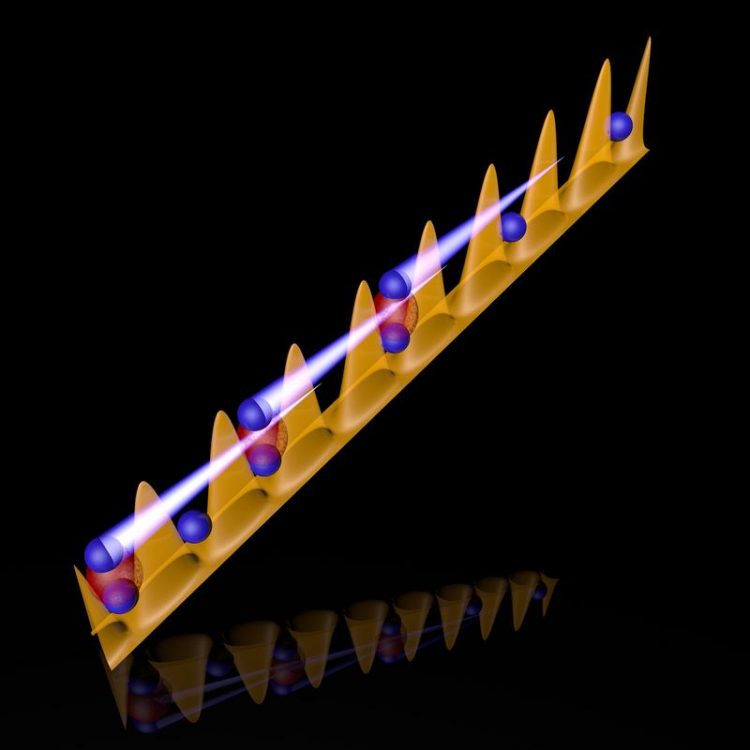Long-range tunneling of quantum particles

Quantum particles transmit through a whole series of barriers under conditions where a single particle could not do the move. Illustration: Uni Innsbruck
Experimental physicists in Innsbruck, Austria, have now directly observed quantum particles transmitting through a whole series of up to five potential barriers under conditions where a single particle could not do the move.
One of the most remarkable consequences of the rules in quantum mechanics is the capability of a quantum particle to penetrate through a potential barrier even though its energy would not allow for the corresponding classical trajectory. This is known as the quantum tunnel effect and manifests itself in a multitude of well-known phenomena.
For example, it explains nuclear radioactive decay, fusion reactions in the interior of stars, and electron transport through quantum dots. Tunneling also is at the heart of many technical applications, for instance it allows for imaging of surfaces on the atomic length scale in scanning tunneling microscopes.
All the above systems have in common that they essentially represent the very fundamental paradigm of the tunnel effect: a single particle that penetrates through a single barrier. Now, the team of Hanns-Christoph Nägerl, Institute for Experimental Physics of the University of Innsbruck, Austria, has directly observed tunneling dynamics in a much more intriguing system:
They see quantum particles transmitting through a whole series of up to five potential barriers under conditions where a single particle could not do the move. Instead the particles need to help each other via their strong mutual interactions and via an effect known as Bose enhancement.
In their experiment the scientists place a gas of Cesium atoms at extremely low temperatures just above absolute zero temperature into a potential landscape that is deliberately engineered by laser light. This so-called optical lattice forms a regular and perfect structure constituting the multiple tunneling barriers, similar to a washboard.
As temperatures are so low and thus the atoms’ kinetic energies are so tiny, the only way to move across the washboard is via tunneling through the barriers. The tunneling motion is initiated by applying a directed force onto the atoms along one of the lattice axes, that is, by tilting the washboard.
It is now one of the crucial points in the experiment that the physicists control through how many barriers the particles penetrate by the interplay between the interaction and the strength of the force in conjunction with Bose enhancement as a result of the particles’ quantum indistinguishability.
Very similar to a massive object moving in the earth’s gravitational field, the tunneling atoms should loose potential energy when they move down the washboard. But where can they deposit this energy in such a perfect and frictionless environment?
It’s the interaction energy between the atoms when they share the same site of the lattice that compensates for the potential energy. As a result, the physicists found that the tunneling motion leads to discrete resonances corresponding to the number of barriers the particles penetrate through.
It is left for the future to explore the role of such long-range tunneling processes for lattice systems with ultracold atoms in the context of quantum simulation and quantum information processing, or for different physical settings, for instance electronic quantum devices, molecular or even biological systems.
Publication: Observation of many-body dynamics in long-range tunneling after a quantum quench. Florian Meinert, Manfred J. Mark, Emil Kirilov, Katharina Lauber, Philipp Weinmann, Michael Gröbner, Andrew J. Daley, Hanns-Christoph Nägerl. Science 2014 DOI: 10.1126/science.1248402 (arXiv:1312.2758)
Contact
Univ.-Prof. Dr. Hanns-Christoph Nägerl
Institute for Experimental Physics
University of Innsbruck
phone: +43 512 507 52420
email: christoph.naegerl@uibk.ac.at
Christian Flatz
Public Relations
University of Innsbruck
phone: +43 512 507 32022
email: christian.flatz@uibk.ac.at
http://dx.doi.org/10.1126/science.1248402 – Observation of many-body dynamics in long-range tunneling after a quantum quench. Florian Meinert, Manfred J. Mark, Emil Kirilov, Katharina Lauber, Philipp Weinmann, Michael Gröbner, Andrew J. Daley, Hanns-Christoph Nägerl. Science 2014
Media Contact
More Information:
http://www.uibk.ac.atAll latest news from the category: Physics and Astronomy
This area deals with the fundamental laws and building blocks of nature and how they interact, the properties and the behavior of matter, and research into space and time and their structures.
innovations-report provides in-depth reports and articles on subjects such as astrophysics, laser technologies, nuclear, quantum, particle and solid-state physics, nanotechnologies, planetary research and findings (Mars, Venus) and developments related to the Hubble Telescope.
Newest articles

NASA: Mystery of life’s handedness deepens
The mystery of why life uses molecules with specific orientations has deepened with a NASA-funded discovery that RNA — a key molecule thought to have potentially held the instructions for…

What are the effects of historic lithium mining on water quality?
Study reveals low levels of common contaminants but high levels of other elements in waters associated with an abandoned lithium mine. Lithium ore and mining waste from a historic lithium…

Quantum-inspired design boosts efficiency of heat-to-electricity conversion
Rice engineers take unconventional route to improving thermophotovoltaic systems. Researchers at Rice University have found a new way to improve a key element of thermophotovoltaic (TPV) systems, which convert heat…



